Management Accounting: Processes, Tools, and Adaptation to Financial Problems
VerifiedAdded on 2023/01/03
|14
|2511
|42
AI Summary
This document provides an overview of management accounting processes and practices, focusing on the case of Prime Furniture. It covers topics such as cost calculation, different planning tools, and the advantages and disadvantages of these tools. It also explores how organizations adapt their management accounting systems to respond to financial problems. The document offers insights into the importance of management accounting in decision-making and financial governance.
Contribute Materials
Your contribution can guide someone’s learning journey. Share your
documents today.
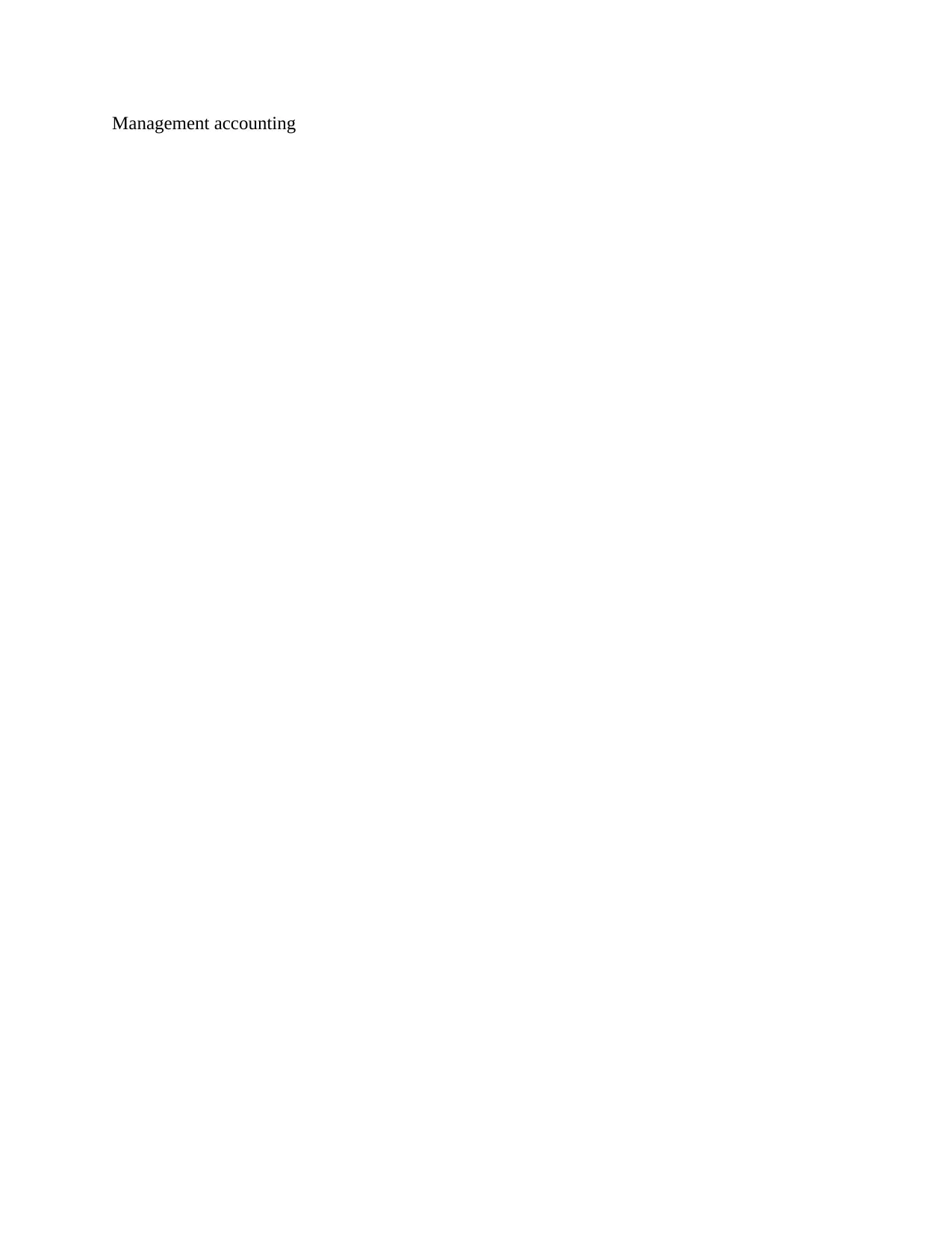
Management accounting
Secure Best Marks with AI Grader
Need help grading? Try our AI Grader for instant feedback on your assignments.
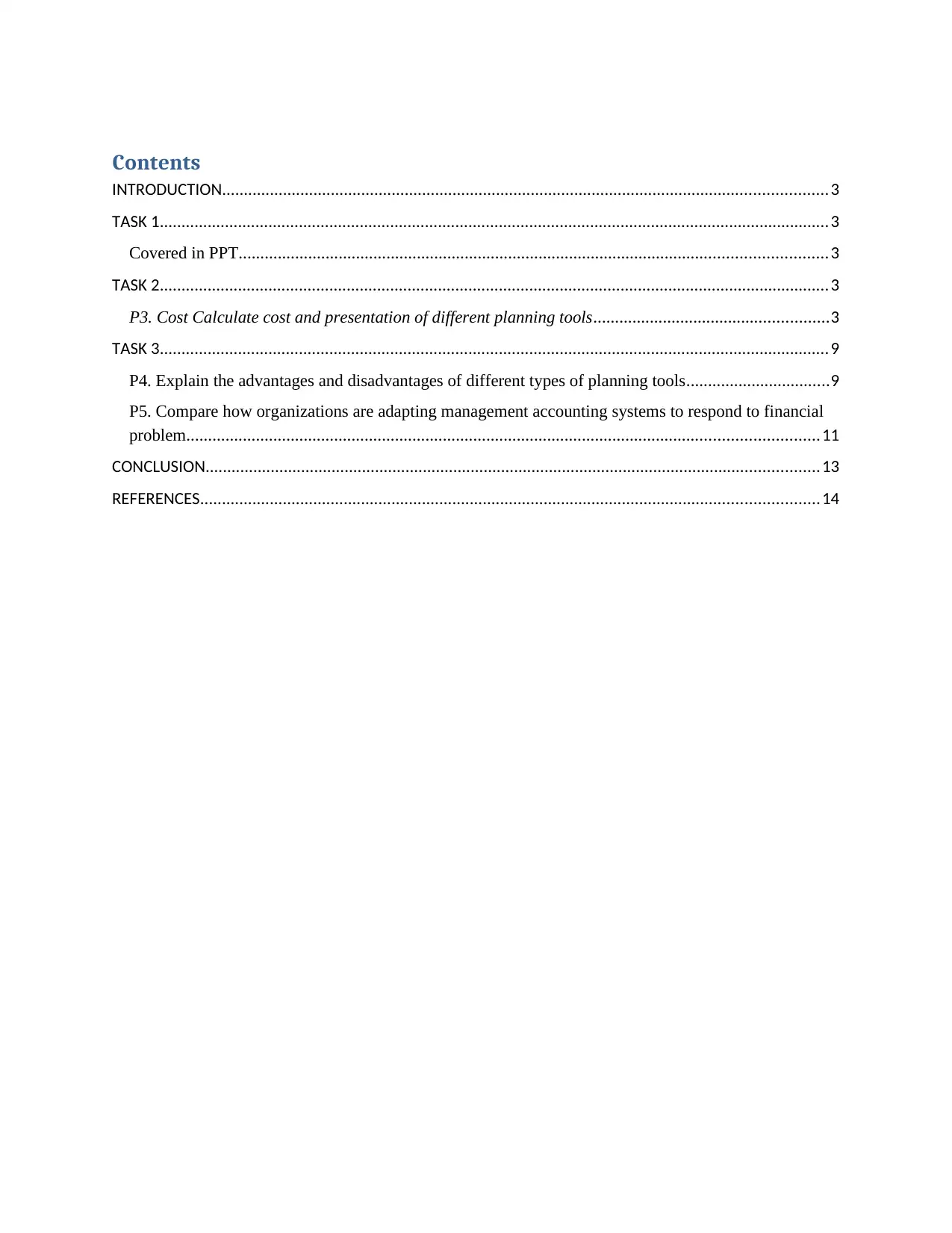
Contents
INTRODUCTION...........................................................................................................................................3
TASK 1..........................................................................................................................................................3
Covered in PPT.......................................................................................................................................3
TASK 2..........................................................................................................................................................3
P3. Cost Calculate cost and presentation of different planning tools......................................................3
TASK 3..........................................................................................................................................................9
P4. Explain the advantages and disadvantages of different types of planning tools.................................9
P5. Compare how organizations are adapting management accounting systems to respond to financial
problem.................................................................................................................................................11
CONCLUSION.............................................................................................................................................13
REFERENCES..............................................................................................................................................14
INTRODUCTION...........................................................................................................................................3
TASK 1..........................................................................................................................................................3
Covered in PPT.......................................................................................................................................3
TASK 2..........................................................................................................................................................3
P3. Cost Calculate cost and presentation of different planning tools......................................................3
TASK 3..........................................................................................................................................................9
P4. Explain the advantages and disadvantages of different types of planning tools.................................9
P5. Compare how organizations are adapting management accounting systems to respond to financial
problem.................................................................................................................................................11
CONCLUSION.............................................................................................................................................13
REFERENCES..............................................................................................................................................14
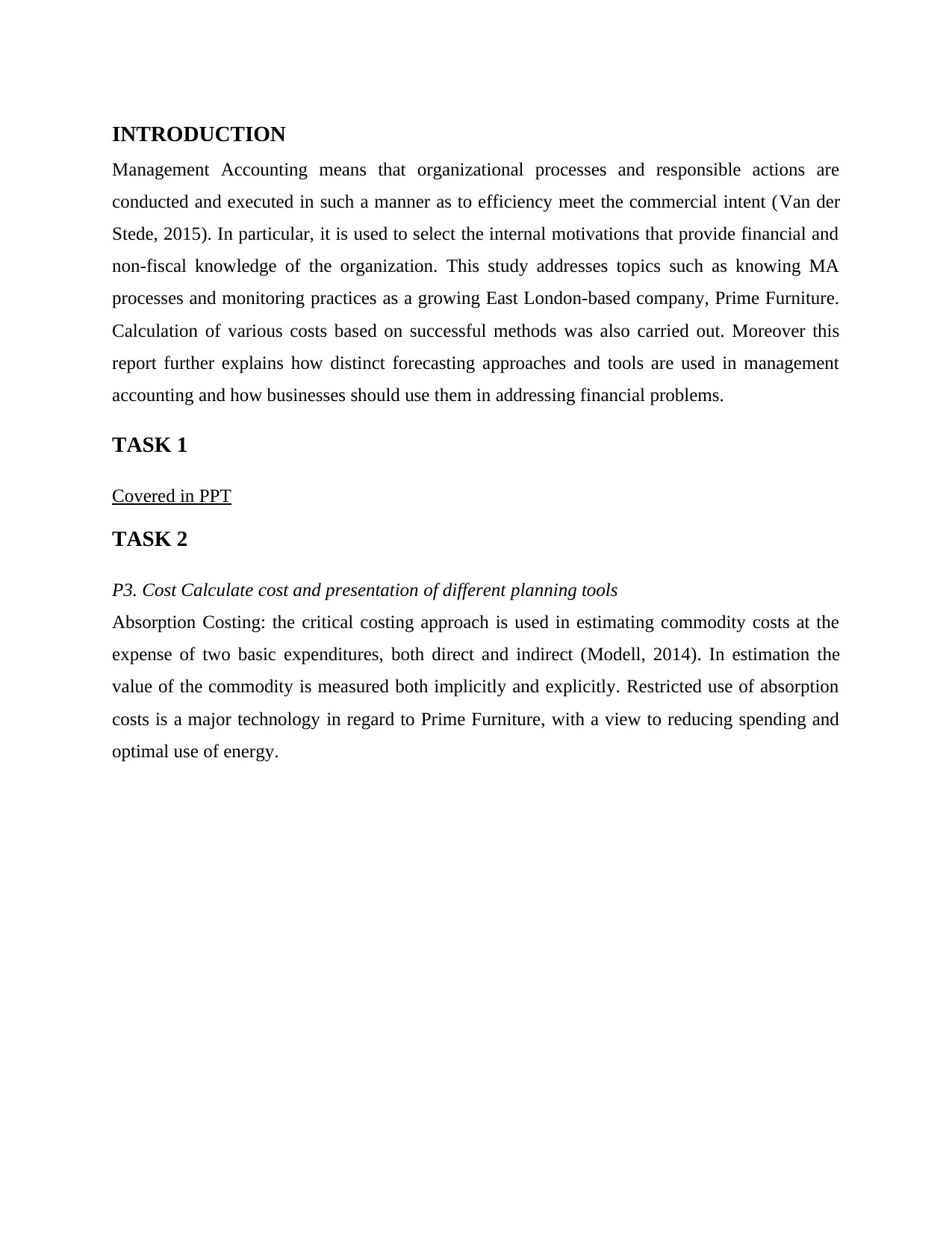
INTRODUCTION
Management Accounting means that organizational processes and responsible actions are
conducted and executed in such a manner as to efficiency meet the commercial intent (Van der
Stede, 2015). In particular, it is used to select the internal motivations that provide financial and
non-fiscal knowledge of the organization. This study addresses topics such as knowing MA
processes and monitoring practices as a growing East London-based company, Prime Furniture.
Calculation of various costs based on successful methods was also carried out. Moreover this
report further explains how distinct forecasting approaches and tools are used in management
accounting and how businesses should use them in addressing financial problems.
TASK 1
Covered in PPT
TASK 2
P3. Cost Calculate cost and presentation of different planning tools
Absorption Costing: the critical costing approach is used in estimating commodity costs at the
expense of two basic expenditures, both direct and indirect (Modell, 2014). In estimation the
value of the commodity is measured both implicitly and explicitly. Restricted use of absorption
costs is a major technology in regard to Prime Furniture, with a view to reducing spending and
optimal use of energy.
Management Accounting means that organizational processes and responsible actions are
conducted and executed in such a manner as to efficiency meet the commercial intent (Van der
Stede, 2015). In particular, it is used to select the internal motivations that provide financial and
non-fiscal knowledge of the organization. This study addresses topics such as knowing MA
processes and monitoring practices as a growing East London-based company, Prime Furniture.
Calculation of various costs based on successful methods was also carried out. Moreover this
report further explains how distinct forecasting approaches and tools are used in management
accounting and how businesses should use them in addressing financial problems.
TASK 1
Covered in PPT
TASK 2
P3. Cost Calculate cost and presentation of different planning tools
Absorption Costing: the critical costing approach is used in estimating commodity costs at the
expense of two basic expenditures, both direct and indirect (Modell, 2014). In estimation the
value of the commodity is measured both implicitly and explicitly. Restricted use of absorption
costs is a major technology in regard to Prime Furniture, with a view to reducing spending and
optimal use of energy.
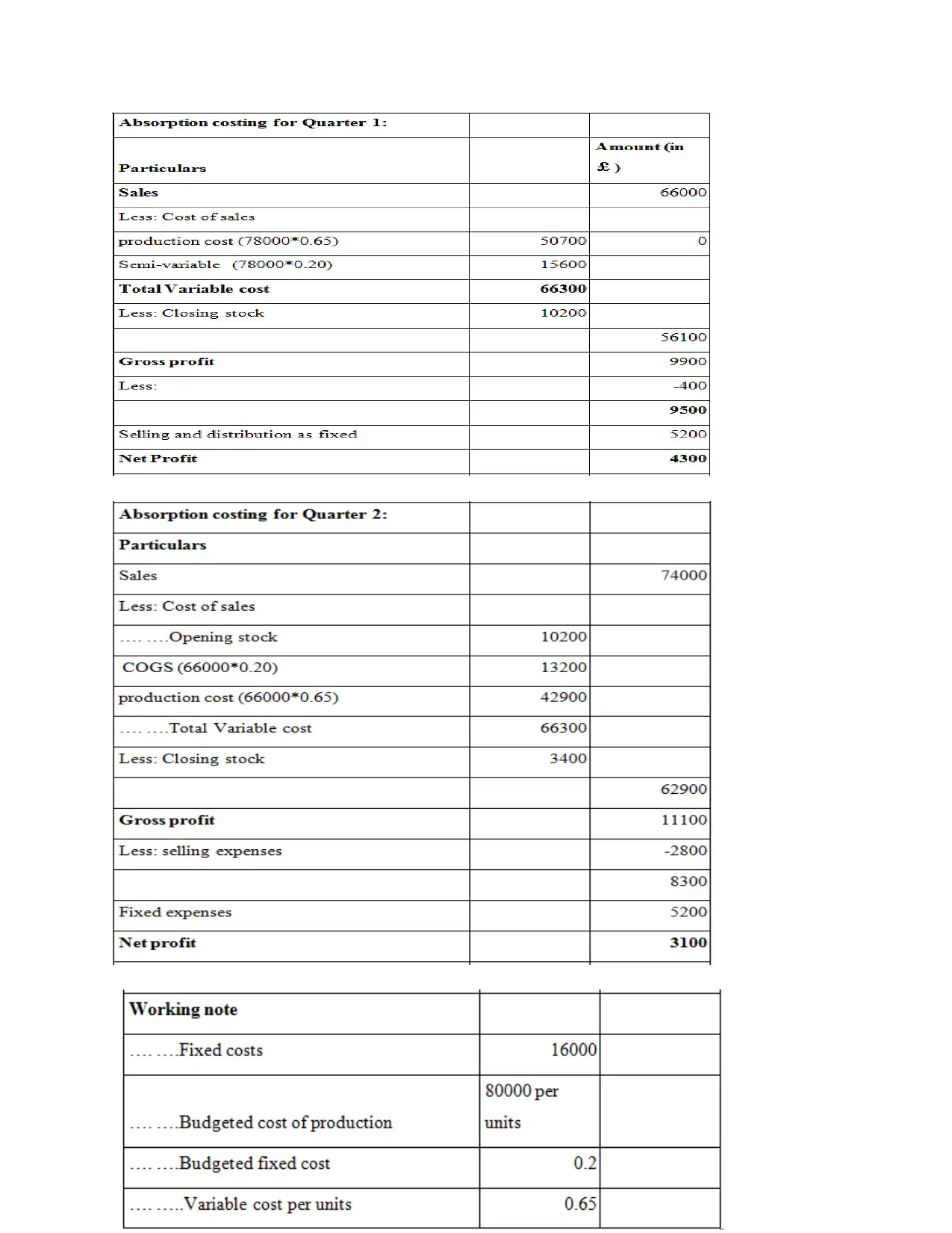
Secure Best Marks with AI Grader
Need help grading? Try our AI Grader for instant feedback on your assignments.
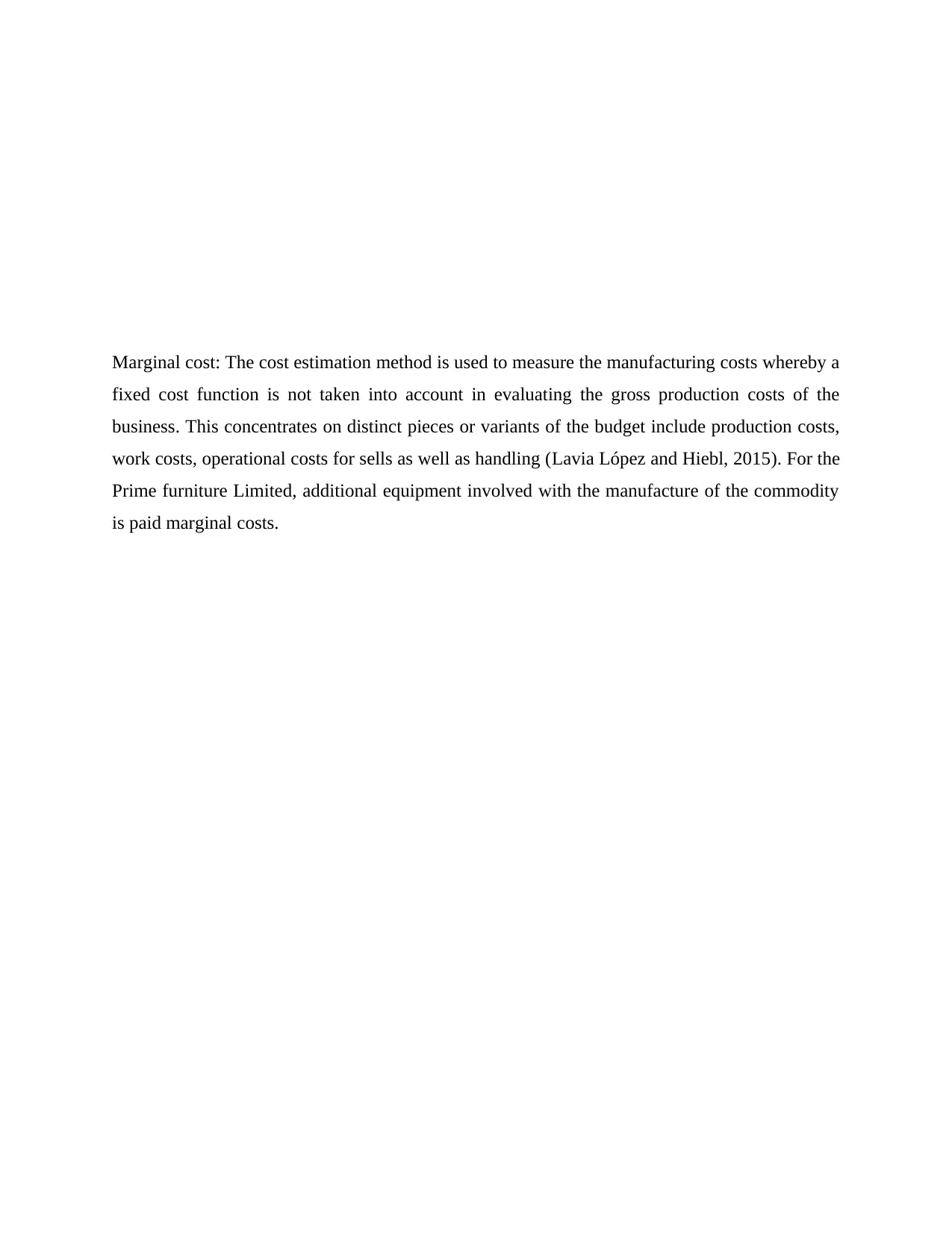
Marginal cost: The cost estimation method is used to measure the manufacturing costs whereby a
fixed cost function is not taken into account in evaluating the gross production costs of the
business. This concentrates on distinct pieces or variants of the budget include production costs,
work costs, operational costs for sells as well as handling (Lavia López and Hiebl, 2015). For the
Prime furniture Limited, additional equipment involved with the manufacture of the commodity
is paid marginal costs.
fixed cost function is not taken into account in evaluating the gross production costs of the
business. This concentrates on distinct pieces or variants of the budget include production costs,
work costs, operational costs for sells as well as handling (Lavia López and Hiebl, 2015). For the
Prime furniture Limited, additional equipment involved with the manufacture of the commodity
is paid marginal costs.
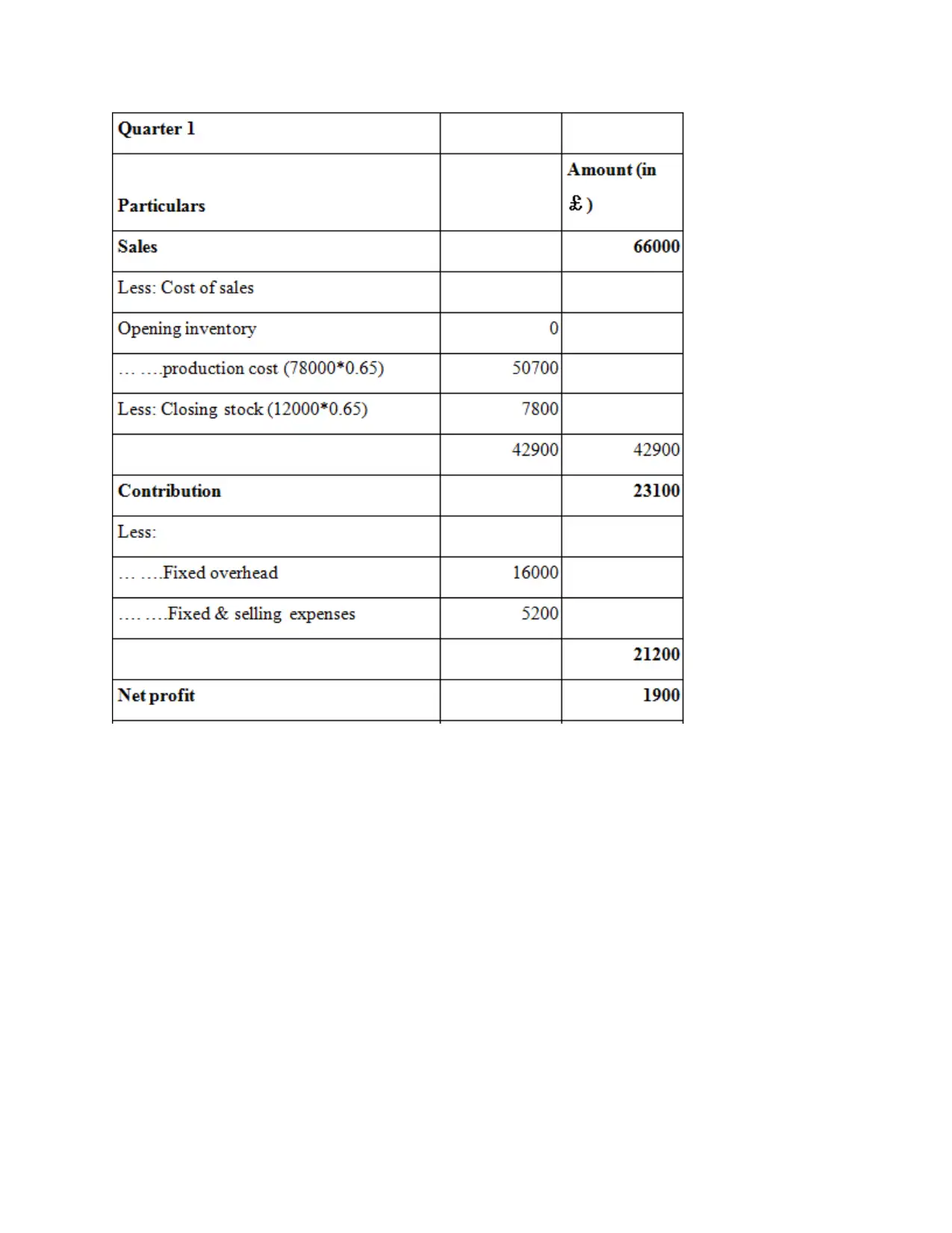
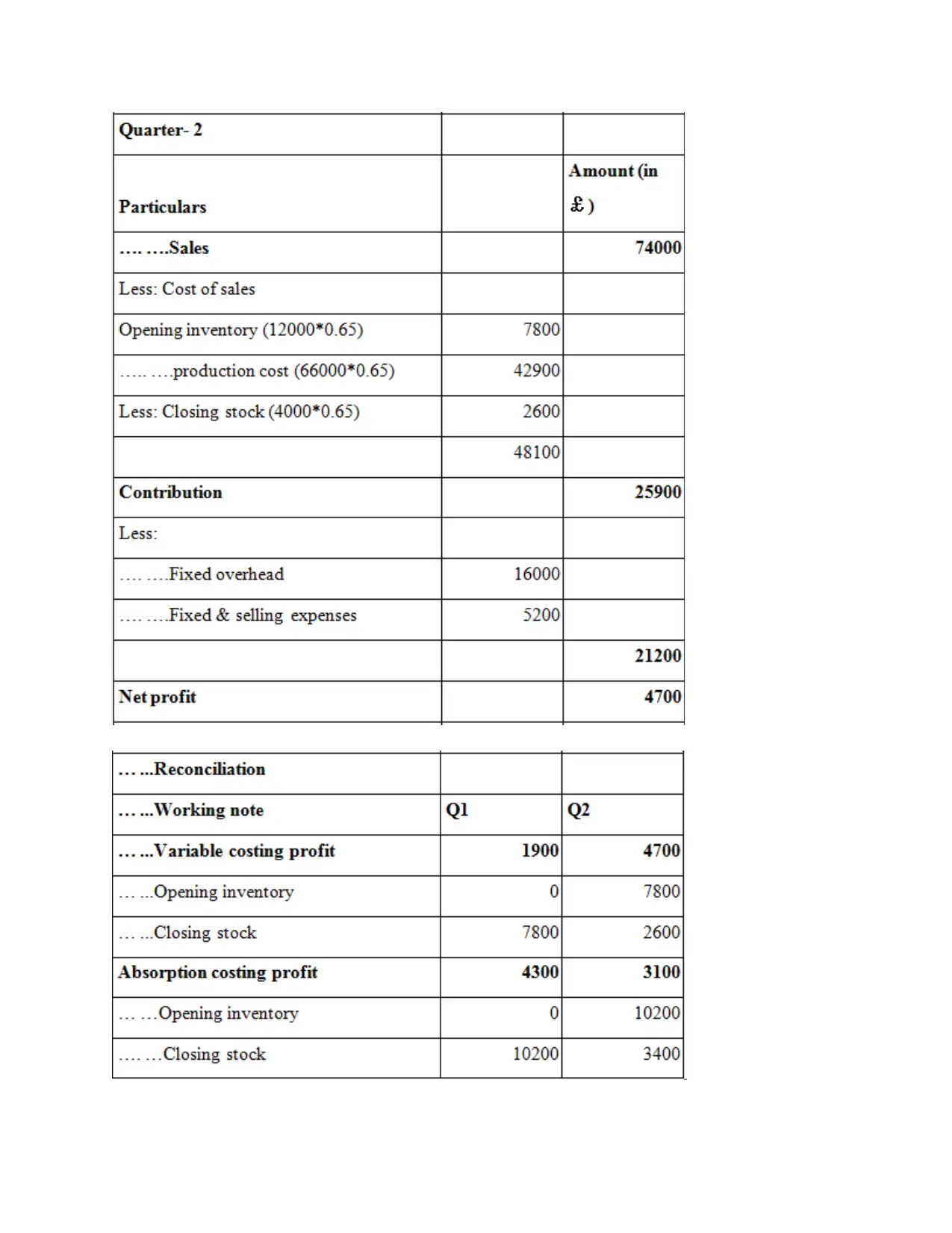
Paraphrase This Document
Need a fresh take? Get an instant paraphrase of this document with our AI Paraphraser
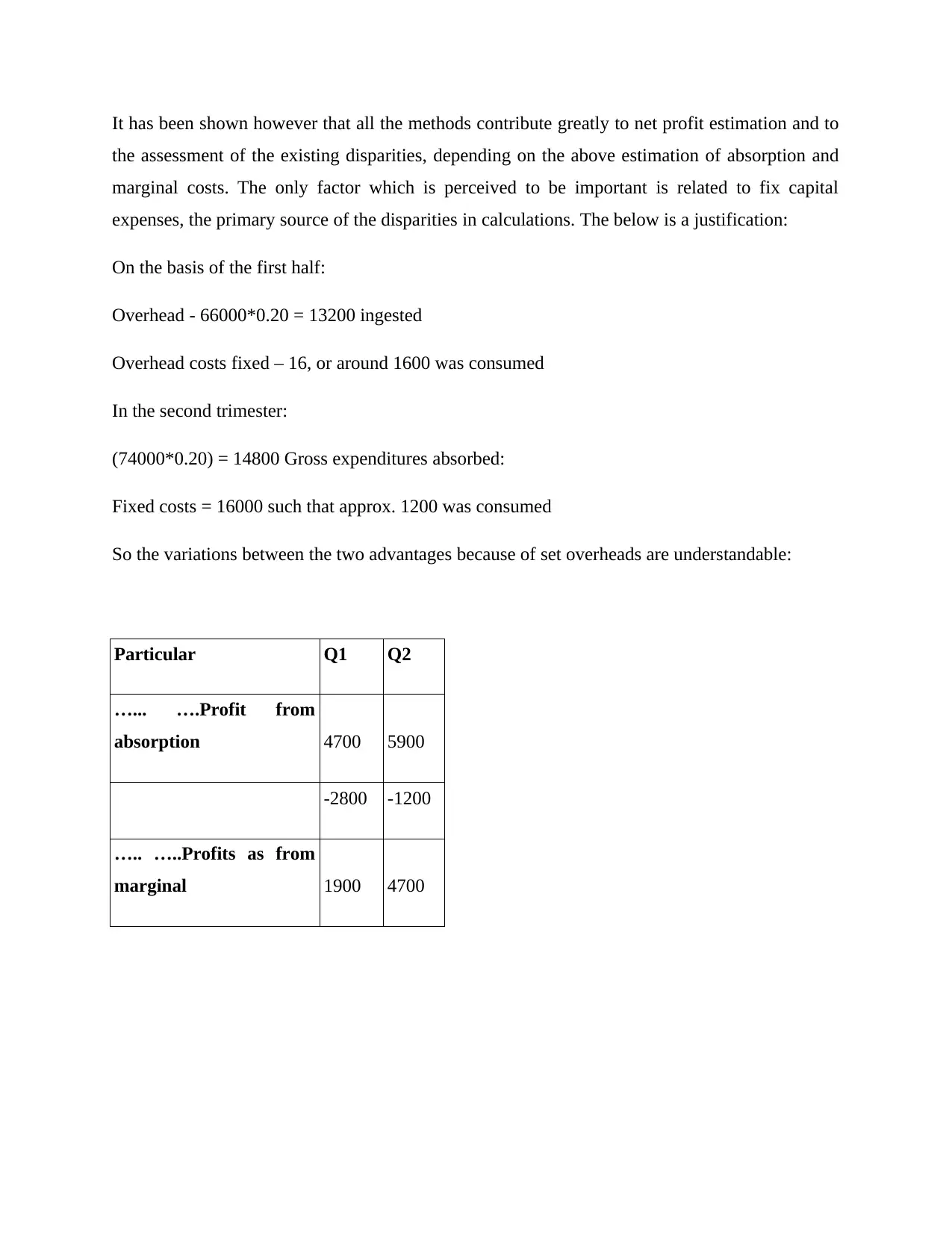
It has been shown however that all the methods contribute greatly to net profit estimation and to
the assessment of the existing disparities, depending on the above estimation of absorption and
marginal costs. The only factor which is perceived to be important is related to fix capital
expenses, the primary source of the disparities in calculations. The below is a justification:
On the basis of the first half:
Overhead - 66000*0.20 = 13200 ingested
Overhead costs fixed – 16, or around 1600 was consumed
In the second trimester:
(74000*0.20) = 14800 Gross expenditures absorbed:
Fixed costs = 16000 such that approx. 1200 was consumed
So the variations between the two advantages because of set overheads are understandable:
Particular Q1 Q2
…... ….Profit from
absorption 4700 5900
-2800 -1200
….. …..Profits as from
marginal 1900 4700
the assessment of the existing disparities, depending on the above estimation of absorption and
marginal costs. The only factor which is perceived to be important is related to fix capital
expenses, the primary source of the disparities in calculations. The below is a justification:
On the basis of the first half:
Overhead - 66000*0.20 = 13200 ingested
Overhead costs fixed – 16, or around 1600 was consumed
In the second trimester:
(74000*0.20) = 14800 Gross expenditures absorbed:
Fixed costs = 16000 such that approx. 1200 was consumed
So the variations between the two advantages because of set overheads are understandable:
Particular Q1 Q2
…... ….Profit from
absorption 4700 5900
-2800 -1200
….. …..Profits as from
marginal 1900 4700
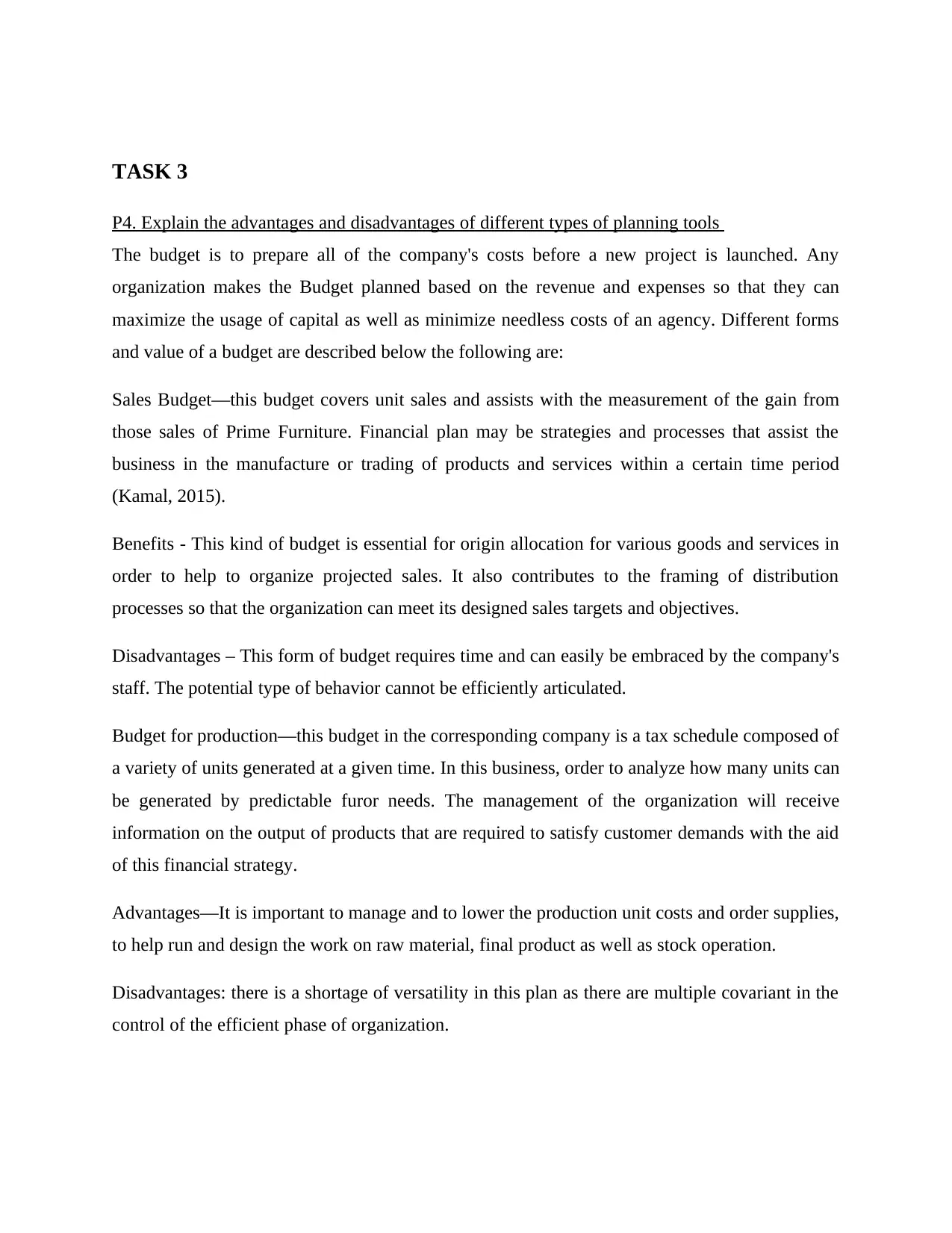
TASK 3
P4. Explain the advantages and disadvantages of different types of planning tools
The budget is to prepare all of the company's costs before a new project is launched. Any
organization makes the Budget planned based on the revenue and expenses so that they can
maximize the usage of capital as well as minimize needless costs of an agency. Different forms
and value of a budget are described below the following are:
Sales Budget—this budget covers unit sales and assists with the measurement of the gain from
those sales of Prime Furniture. Financial plan may be strategies and processes that assist the
business in the manufacture or trading of products and services within a certain time period
(Kamal, 2015).
Benefits - This kind of budget is essential for origin allocation for various goods and services in
order to help to organize projected sales. It also contributes to the framing of distribution
processes so that the organization can meet its designed sales targets and objectives.
Disadvantages – This form of budget requires time and can easily be embraced by the company's
staff. The potential type of behavior cannot be efficiently articulated.
Budget for production—this budget in the corresponding company is a tax schedule composed of
a variety of units generated at a given time. In this business, order to analyze how many units can
be generated by predictable furor needs. The management of the organization will receive
information on the output of products that are required to satisfy customer demands with the aid
of this financial strategy.
Advantages—It is important to manage and to lower the production unit costs and order supplies,
to help run and design the work on raw material, final product as well as stock operation.
Disadvantages: there is a shortage of versatility in this plan as there are multiple covariant in the
control of the efficient phase of organization.
P4. Explain the advantages and disadvantages of different types of planning tools
The budget is to prepare all of the company's costs before a new project is launched. Any
organization makes the Budget planned based on the revenue and expenses so that they can
maximize the usage of capital as well as minimize needless costs of an agency. Different forms
and value of a budget are described below the following are:
Sales Budget—this budget covers unit sales and assists with the measurement of the gain from
those sales of Prime Furniture. Financial plan may be strategies and processes that assist the
business in the manufacture or trading of products and services within a certain time period
(Kamal, 2015).
Benefits - This kind of budget is essential for origin allocation for various goods and services in
order to help to organize projected sales. It also contributes to the framing of distribution
processes so that the organization can meet its designed sales targets and objectives.
Disadvantages – This form of budget requires time and can easily be embraced by the company's
staff. The potential type of behavior cannot be efficiently articulated.
Budget for production—this budget in the corresponding company is a tax schedule composed of
a variety of units generated at a given time. In this business, order to analyze how many units can
be generated by predictable furor needs. The management of the organization will receive
information on the output of products that are required to satisfy customer demands with the aid
of this financial strategy.
Advantages—It is important to manage and to lower the production unit costs and order supplies,
to help run and design the work on raw material, final product as well as stock operation.
Disadvantages: there is a shortage of versatility in this plan as there are multiple covariant in the
control of the efficient phase of organization.
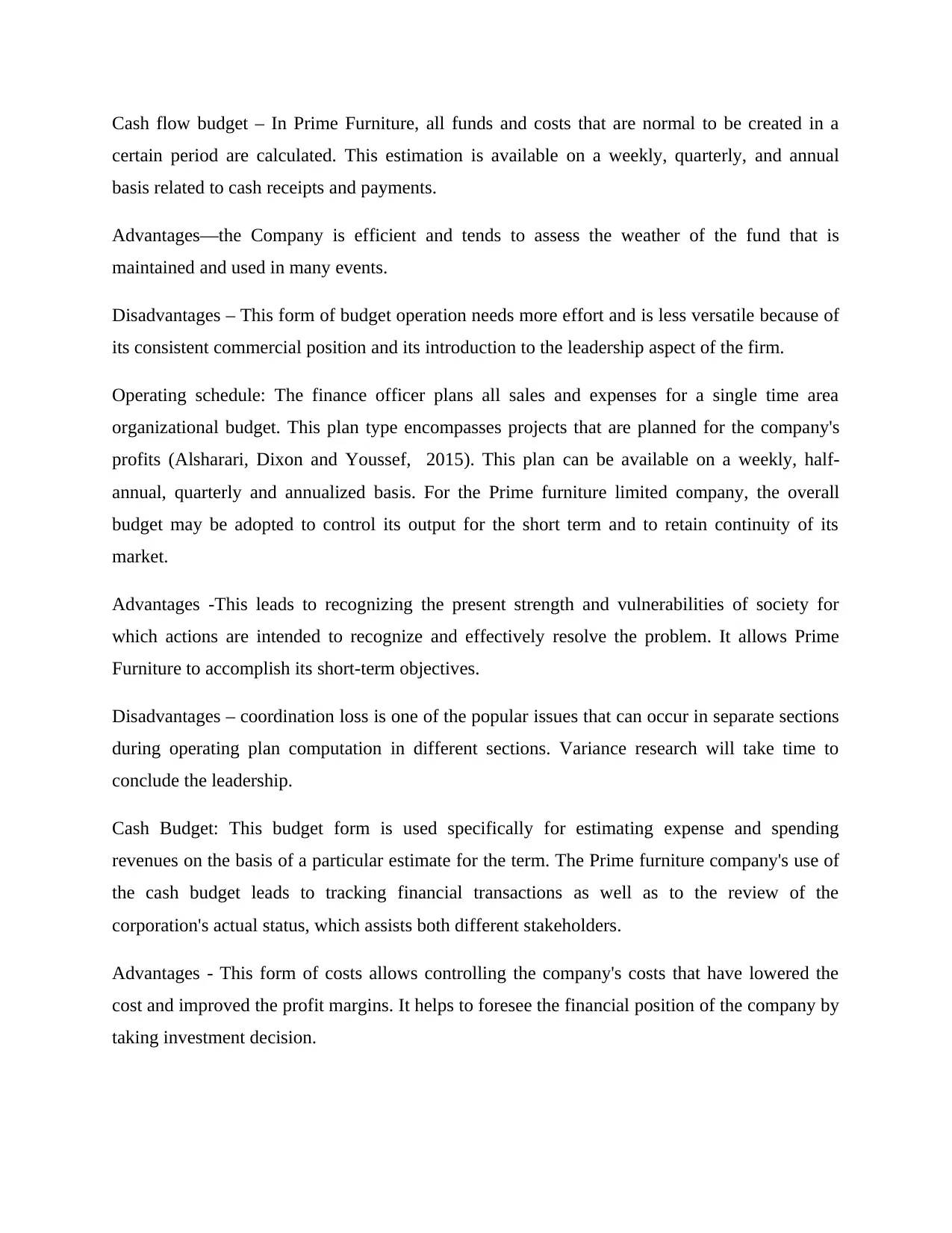
Cash flow budget – In Prime Furniture, all funds and costs that are normal to be created in a
certain period are calculated. This estimation is available on a weekly, quarterly, and annual
basis related to cash receipts and payments.
Advantages—the Company is efficient and tends to assess the weather of the fund that is
maintained and used in many events.
Disadvantages – This form of budget operation needs more effort and is less versatile because of
its consistent commercial position and its introduction to the leadership aspect of the firm.
Operating schedule: The finance officer plans all sales and expenses for a single time area
organizational budget. This plan type encompasses projects that are planned for the company's
profits (Alsharari, Dixon and Youssef, 2015). This plan can be available on a weekly, half-
annual, quarterly and annualized basis. For the Prime furniture limited company, the overall
budget may be adopted to control its output for the short term and to retain continuity of its
market.
Advantages -This leads to recognizing the present strength and vulnerabilities of society for
which actions are intended to recognize and effectively resolve the problem. It allows Prime
Furniture to accomplish its short-term objectives.
Disadvantages – coordination loss is one of the popular issues that can occur in separate sections
during operating plan computation in different sections. Variance research will take time to
conclude the leadership.
Cash Budget: This budget form is used specifically for estimating expense and spending
revenues on the basis of a particular estimate for the term. The Prime furniture company's use of
the cash budget leads to tracking financial transactions as well as to the review of the
corporation's actual status, which assists both different stakeholders.
Advantages - This form of costs allows controlling the company's costs that have lowered the
cost and improved the profit margins. It helps to foresee the financial position of the company by
taking investment decision.
certain period are calculated. This estimation is available on a weekly, quarterly, and annual
basis related to cash receipts and payments.
Advantages—the Company is efficient and tends to assess the weather of the fund that is
maintained and used in many events.
Disadvantages – This form of budget operation needs more effort and is less versatile because of
its consistent commercial position and its introduction to the leadership aspect of the firm.
Operating schedule: The finance officer plans all sales and expenses for a single time area
organizational budget. This plan type encompasses projects that are planned for the company's
profits (Alsharari, Dixon and Youssef, 2015). This plan can be available on a weekly, half-
annual, quarterly and annualized basis. For the Prime furniture limited company, the overall
budget may be adopted to control its output for the short term and to retain continuity of its
market.
Advantages -This leads to recognizing the present strength and vulnerabilities of society for
which actions are intended to recognize and effectively resolve the problem. It allows Prime
Furniture to accomplish its short-term objectives.
Disadvantages – coordination loss is one of the popular issues that can occur in separate sections
during operating plan computation in different sections. Variance research will take time to
conclude the leadership.
Cash Budget: This budget form is used specifically for estimating expense and spending
revenues on the basis of a particular estimate for the term. The Prime furniture company's use of
the cash budget leads to tracking financial transactions as well as to the review of the
corporation's actual status, which assists both different stakeholders.
Advantages - This form of costs allows controlling the company's costs that have lowered the
cost and improved the profit margins. It helps to foresee the financial position of the company by
taking investment decision.
Secure Best Marks with AI Grader
Need help grading? Try our AI Grader for instant feedback on your assignments.
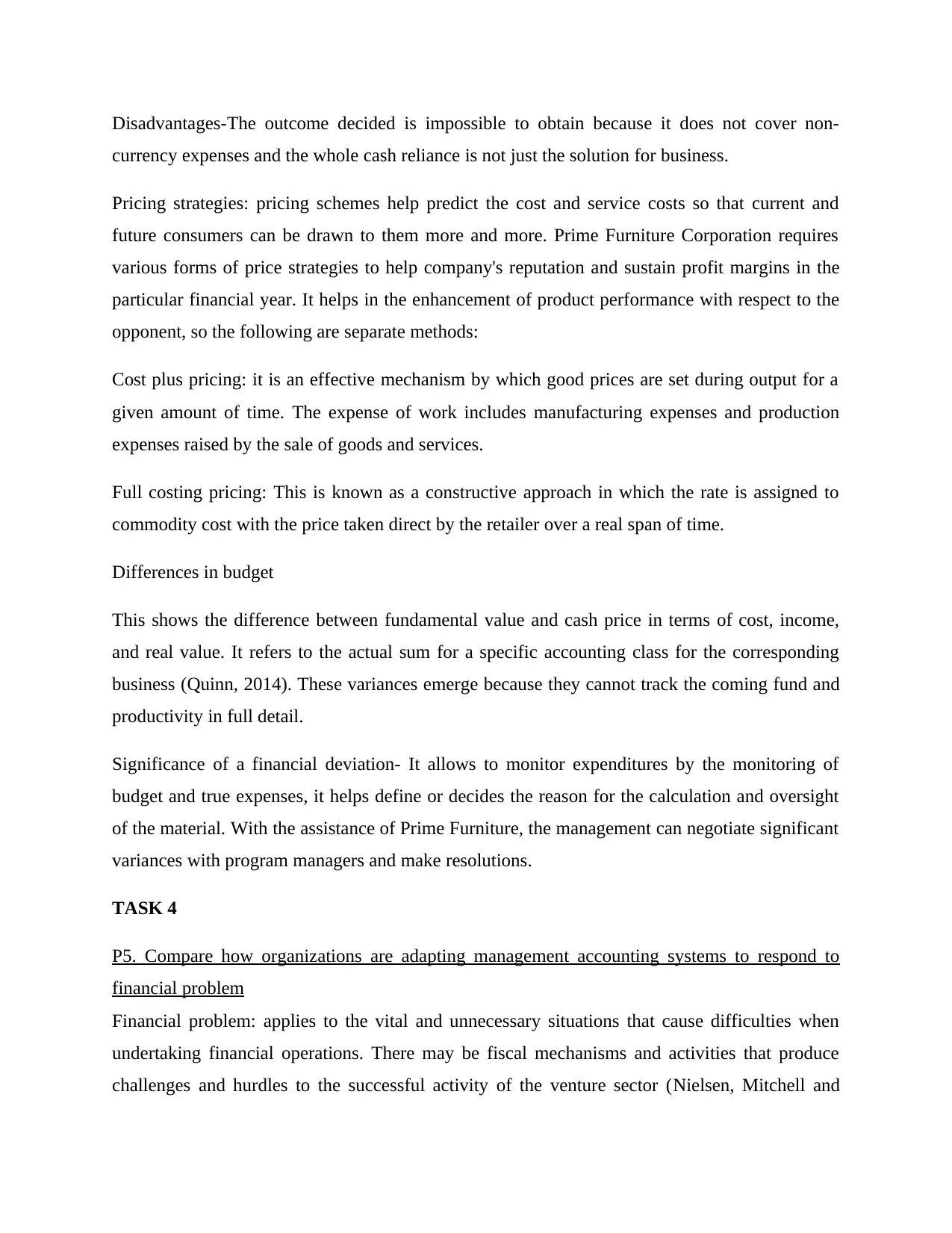
Disadvantages-The outcome decided is impossible to obtain because it does not cover non-
currency expenses and the whole cash reliance is not just the solution for business.
Pricing strategies: pricing schemes help predict the cost and service costs so that current and
future consumers can be drawn to them more and more. Prime Furniture Corporation requires
various forms of price strategies to help company's reputation and sustain profit margins in the
particular financial year. It helps in the enhancement of product performance with respect to the
opponent, so the following are separate methods:
Cost plus pricing: it is an effective mechanism by which good prices are set during output for a
given amount of time. The expense of work includes manufacturing expenses and production
expenses raised by the sale of goods and services.
Full costing pricing: This is known as a constructive approach in which the rate is assigned to
commodity cost with the price taken direct by the retailer over a real span of time.
Differences in budget
This shows the difference between fundamental value and cash price in terms of cost, income,
and real value. It refers to the actual sum for a specific accounting class for the corresponding
business (Quinn, 2014). These variances emerge because they cannot track the coming fund and
productivity in full detail.
Significance of a financial deviation- It allows to monitor expenditures by the monitoring of
budget and true expenses, it helps define or decides the reason for the calculation and oversight
of the material. With the assistance of Prime Furniture, the management can negotiate significant
variances with program managers and make resolutions.
TASK 4
P5. Compare how organizations are adapting management accounting systems to respond to
financial problem
Financial problem: applies to the vital and unnecessary situations that cause difficulties when
undertaking financial operations. There may be fiscal mechanisms and activities that produce
challenges and hurdles to the successful activity of the venture sector (Nielsen, Mitchell and
currency expenses and the whole cash reliance is not just the solution for business.
Pricing strategies: pricing schemes help predict the cost and service costs so that current and
future consumers can be drawn to them more and more. Prime Furniture Corporation requires
various forms of price strategies to help company's reputation and sustain profit margins in the
particular financial year. It helps in the enhancement of product performance with respect to the
opponent, so the following are separate methods:
Cost plus pricing: it is an effective mechanism by which good prices are set during output for a
given amount of time. The expense of work includes manufacturing expenses and production
expenses raised by the sale of goods and services.
Full costing pricing: This is known as a constructive approach in which the rate is assigned to
commodity cost with the price taken direct by the retailer over a real span of time.
Differences in budget
This shows the difference between fundamental value and cash price in terms of cost, income,
and real value. It refers to the actual sum for a specific accounting class for the corresponding
business (Quinn, 2014). These variances emerge because they cannot track the coming fund and
productivity in full detail.
Significance of a financial deviation- It allows to monitor expenditures by the monitoring of
budget and true expenses, it helps define or decides the reason for the calculation and oversight
of the material. With the assistance of Prime Furniture, the management can negotiate significant
variances with program managers and make resolutions.
TASK 4
P5. Compare how organizations are adapting management accounting systems to respond to
financial problem
Financial problem: applies to the vital and unnecessary situations that cause difficulties when
undertaking financial operations. There may be fiscal mechanisms and activities that produce
challenges and hurdles to the successful activity of the venture sector (Nielsen, Mitchell and
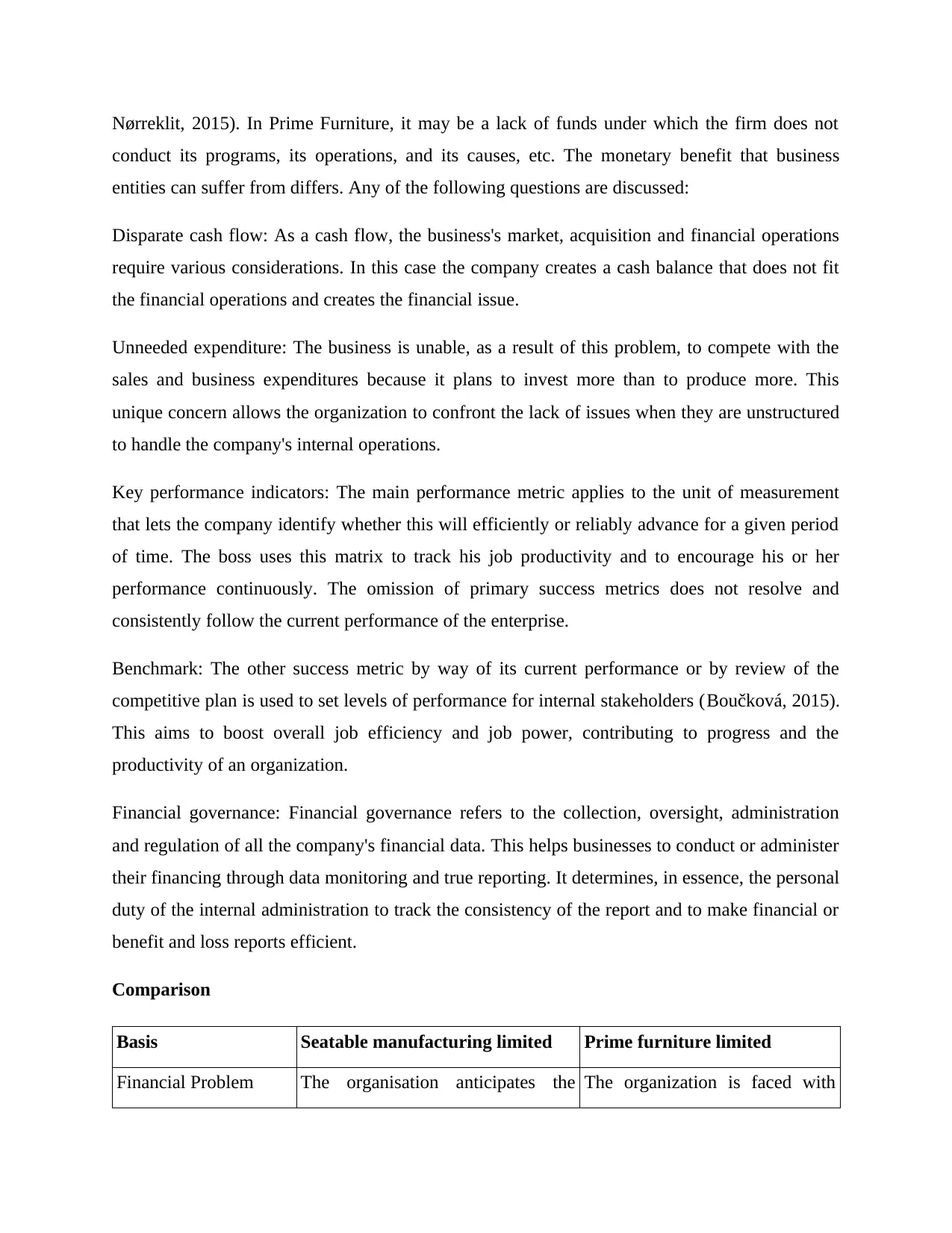
Nørreklit, 2015). In Prime Furniture, it may be a lack of funds under which the firm does not
conduct its programs, its operations, and its causes, etc. The monetary benefit that business
entities can suffer from differs. Any of the following questions are discussed:
Disparate cash flow: As a cash flow, the business's market, acquisition and financial operations
require various considerations. In this case the company creates a cash balance that does not fit
the financial operations and creates the financial issue.
Unneeded expenditure: The business is unable, as a result of this problem, to compete with the
sales and business expenditures because it plans to invest more than to produce more. This
unique concern allows the organization to confront the lack of issues when they are unstructured
to handle the company's internal operations.
Key performance indicators: The main performance metric applies to the unit of measurement
that lets the company identify whether this will efficiently or reliably advance for a given period
of time. The boss uses this matrix to track his job productivity and to encourage his or her
performance continuously. The omission of primary success metrics does not resolve and
consistently follow the current performance of the enterprise.
Benchmark: The other success metric by way of its current performance or by review of the
competitive plan is used to set levels of performance for internal stakeholders (Boučková, 2015).
This aims to boost overall job efficiency and job power, contributing to progress and the
productivity of an organization.
Financial governance: Financial governance refers to the collection, oversight, administration
and regulation of all the company's financial data. This helps businesses to conduct or administer
their financing through data monitoring and true reporting. It determines, in essence, the personal
duty of the internal administration to track the consistency of the report and to make financial or
benefit and loss reports efficient.
Comparison
Basis Seatable manufacturing limited Prime furniture limited
Financial Problem The organisation anticipates the The organization is faced with
conduct its programs, its operations, and its causes, etc. The monetary benefit that business
entities can suffer from differs. Any of the following questions are discussed:
Disparate cash flow: As a cash flow, the business's market, acquisition and financial operations
require various considerations. In this case the company creates a cash balance that does not fit
the financial operations and creates the financial issue.
Unneeded expenditure: The business is unable, as a result of this problem, to compete with the
sales and business expenditures because it plans to invest more than to produce more. This
unique concern allows the organization to confront the lack of issues when they are unstructured
to handle the company's internal operations.
Key performance indicators: The main performance metric applies to the unit of measurement
that lets the company identify whether this will efficiently or reliably advance for a given period
of time. The boss uses this matrix to track his job productivity and to encourage his or her
performance continuously. The omission of primary success metrics does not resolve and
consistently follow the current performance of the enterprise.
Benchmark: The other success metric by way of its current performance or by review of the
competitive plan is used to set levels of performance for internal stakeholders (Boučková, 2015).
This aims to boost overall job efficiency and job power, contributing to progress and the
productivity of an organization.
Financial governance: Financial governance refers to the collection, oversight, administration
and regulation of all the company's financial data. This helps businesses to conduct or administer
their financing through data monitoring and true reporting. It determines, in essence, the personal
duty of the internal administration to track the consistency of the report and to make financial or
benefit and loss reports efficient.
Comparison
Basis Seatable manufacturing limited Prime furniture limited
Financial Problem The organisation anticipates the The organization is faced with
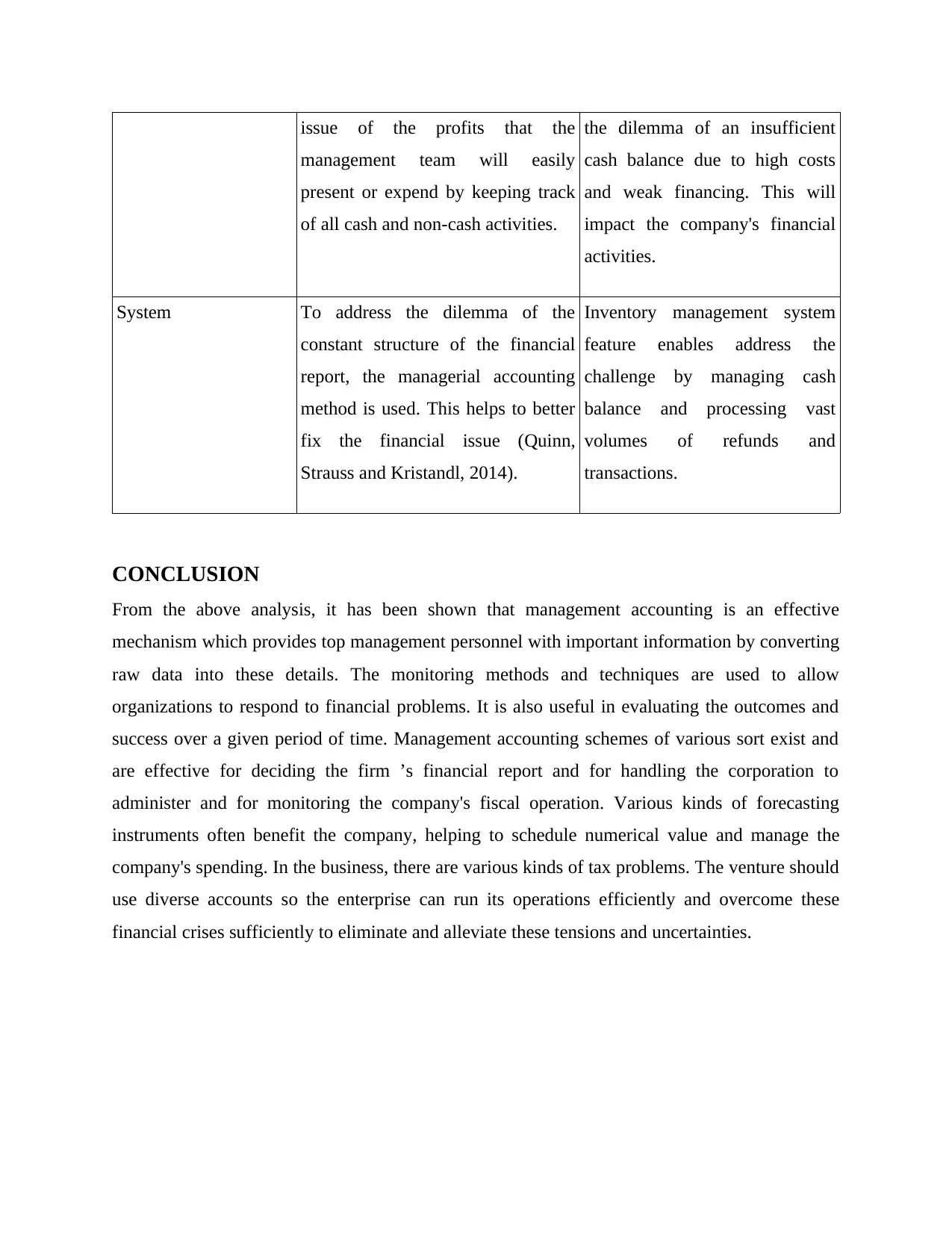
issue of the profits that the
management team will easily
present or expend by keeping track
of all cash and non-cash activities.
the dilemma of an insufficient
cash balance due to high costs
and weak financing. This will
impact the company's financial
activities.
System To address the dilemma of the
constant structure of the financial
report, the managerial accounting
method is used. This helps to better
fix the financial issue (Quinn,
Strauss and Kristandl, 2014).
Inventory management system
feature enables address the
challenge by managing cash
balance and processing vast
volumes of refunds and
transactions.
CONCLUSION
From the above analysis, it has been shown that management accounting is an effective
mechanism which provides top management personnel with important information by converting
raw data into these details. The monitoring methods and techniques are used to allow
organizations to respond to financial problems. It is also useful in evaluating the outcomes and
success over a given period of time. Management accounting schemes of various sort exist and
are effective for deciding the firm ’s financial report and for handling the corporation to
administer and for monitoring the company's fiscal operation. Various kinds of forecasting
instruments often benefit the company, helping to schedule numerical value and manage the
company's spending. In the business, there are various kinds of tax problems. The venture should
use diverse accounts so the enterprise can run its operations efficiently and overcome these
financial crises sufficiently to eliminate and alleviate these tensions and uncertainties.
management team will easily
present or expend by keeping track
of all cash and non-cash activities.
the dilemma of an insufficient
cash balance due to high costs
and weak financing. This will
impact the company's financial
activities.
System To address the dilemma of the
constant structure of the financial
report, the managerial accounting
method is used. This helps to better
fix the financial issue (Quinn,
Strauss and Kristandl, 2014).
Inventory management system
feature enables address the
challenge by managing cash
balance and processing vast
volumes of refunds and
transactions.
CONCLUSION
From the above analysis, it has been shown that management accounting is an effective
mechanism which provides top management personnel with important information by converting
raw data into these details. The monitoring methods and techniques are used to allow
organizations to respond to financial problems. It is also useful in evaluating the outcomes and
success over a given period of time. Management accounting schemes of various sort exist and
are effective for deciding the firm ’s financial report and for handling the corporation to
administer and for monitoring the company's fiscal operation. Various kinds of forecasting
instruments often benefit the company, helping to schedule numerical value and manage the
company's spending. In the business, there are various kinds of tax problems. The venture should
use diverse accounts so the enterprise can run its operations efficiently and overcome these
financial crises sufficiently to eliminate and alleviate these tensions and uncertainties.
Paraphrase This Document
Need a fresh take? Get an instant paraphrase of this document with our AI Paraphraser
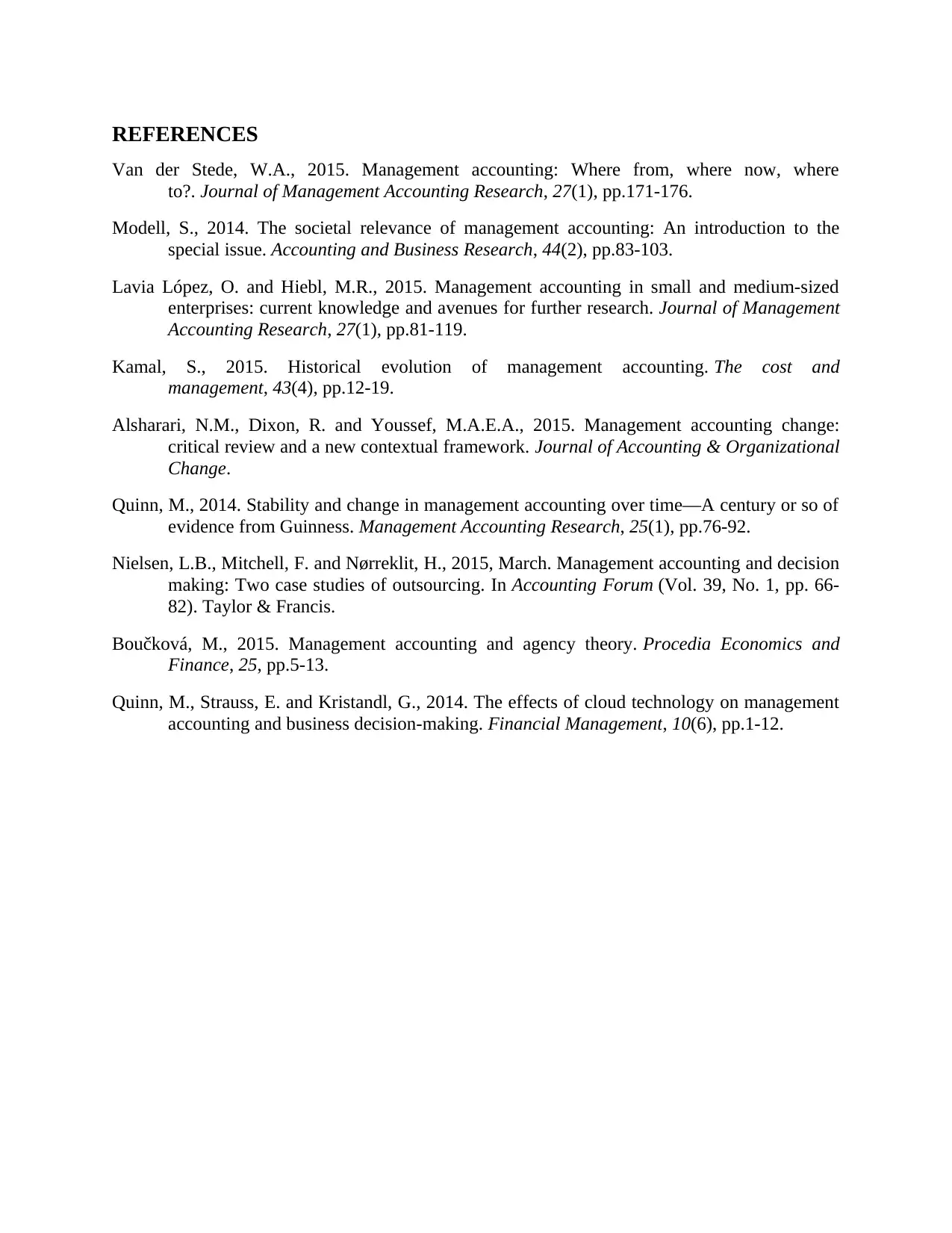
REFERENCES
Van der Stede, W.A., 2015. Management accounting: Where from, where now, where
to?. Journal of Management Accounting Research, 27(1), pp.171-176.
Modell, S., 2014. The societal relevance of management accounting: An introduction to the
special issue. Accounting and Business Research, 44(2), pp.83-103.
Lavia López, O. and Hiebl, M.R., 2015. Management accounting in small and medium-sized
enterprises: current knowledge and avenues for further research. Journal of Management
Accounting Research, 27(1), pp.81-119.
Kamal, S., 2015. Historical evolution of management accounting. The cost and
management, 43(4), pp.12-19.
Alsharari, N.M., Dixon, R. and Youssef, M.A.E.A., 2015. Management accounting change:
critical review and a new contextual framework. Journal of Accounting & Organizational
Change.
Quinn, M., 2014. Stability and change in management accounting over time—A century or so of
evidence from Guinness. Management Accounting Research, 25(1), pp.76-92.
Nielsen, L.B., Mitchell, F. and Nørreklit, H., 2015, March. Management accounting and decision
making: Two case studies of outsourcing. In Accounting Forum (Vol. 39, No. 1, pp. 66-
82). Taylor & Francis.
Boučková, M., 2015. Management accounting and agency theory. Procedia Economics and
Finance, 25, pp.5-13.
Quinn, M., Strauss, E. and Kristandl, G., 2014. The effects of cloud technology on management
accounting and business decision-making. Financial Management, 10(6), pp.1-12.
Van der Stede, W.A., 2015. Management accounting: Where from, where now, where
to?. Journal of Management Accounting Research, 27(1), pp.171-176.
Modell, S., 2014. The societal relevance of management accounting: An introduction to the
special issue. Accounting and Business Research, 44(2), pp.83-103.
Lavia López, O. and Hiebl, M.R., 2015. Management accounting in small and medium-sized
enterprises: current knowledge and avenues for further research. Journal of Management
Accounting Research, 27(1), pp.81-119.
Kamal, S., 2015. Historical evolution of management accounting. The cost and
management, 43(4), pp.12-19.
Alsharari, N.M., Dixon, R. and Youssef, M.A.E.A., 2015. Management accounting change:
critical review and a new contextual framework. Journal of Accounting & Organizational
Change.
Quinn, M., 2014. Stability and change in management accounting over time—A century or so of
evidence from Guinness. Management Accounting Research, 25(1), pp.76-92.
Nielsen, L.B., Mitchell, F. and Nørreklit, H., 2015, March. Management accounting and decision
making: Two case studies of outsourcing. In Accounting Forum (Vol. 39, No. 1, pp. 66-
82). Taylor & Francis.
Boučková, M., 2015. Management accounting and agency theory. Procedia Economics and
Finance, 25, pp.5-13.
Quinn, M., Strauss, E. and Kristandl, G., 2014. The effects of cloud technology on management
accounting and business decision-making. Financial Management, 10(6), pp.1-12.
1 out of 14
Related Documents
Your All-in-One AI-Powered Toolkit for Academic Success.
+13062052269
info@desklib.com
Available 24*7 on WhatsApp / Email
![[object Object]](/_next/static/media/star-bottom.7253800d.svg)
Unlock your academic potential
© 2024 | Zucol Services PVT LTD | All rights reserved.




